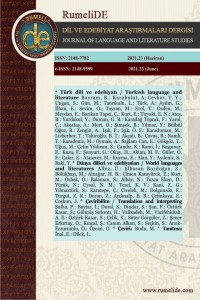Öz
İkinci Dünya Savaşı sonrası dönemde ortaya çıkan postmodern kurgu, yapısal, üslup ve tematik olarak gerçekçilik ve modernizm gibi diğer edebi akımlardan farklı nitelikler taşır. Parçalanmış bir dünyada modernist ve gerçekçi anlam arayışı karşısında sabit dil sistemlerine, ana fikirlere, anlatı stiline ve olay örgüsüne karşı bir meydan okuma veya saldırı olarak algılanabilir. Postmodern kurguda anlatıcının anlaşılması zor, hayal gücüne dayalı, güvenilmez yorumları ve açıklamaları nedeniyle gerçeklik ile ilüzyon arasında her zaman belirsiz bir sınır vardır. 1983 yılında yayımlanan, postmodern edebiyatın başlıca eserlerinden biri olan Salman Rushdie’nin “Utanç” adlı romanı, tarih yazım kurgu tarzında Pakistan'ın çalkantılı bir dönemindeki bazı siyasi konulara ve bazı önemli karakterlere değinerek post-modern romanın en temel özelliklerini sihirli gerçekçilik üslubuyla sergilemektedir. Başlık, ana tema olarak romana hâkimdir ve çeşitli açılardan sorgulanır. Dil, gerçek tarihsel olayları yansıtıyor gibi görünse de, yaratıcı ve öznel bir anlatı tarzı, gerçeklikle kopuşunu ele verir. Utanç, postmodern kurgudaki kopuk anlatım ve yansıması, öznenin merkezden uzaklaşması, araçların kurgusal çerçevesi ve çoklu ortam, gerçeğin benzerleriyle, sihirli gerçekçilik ve tarih yazımında üst kurgu ile yer değiştirmesi gibi temel özelliklerinden dolayı 'postmodern bir roman' olarak adlandırılmayı hak etmektedir. Bu nedenle, bu çalışmanın amacı, gerçekçilik ve modernizm gibi akımlarla olan benzerlik ve farklılıklarına da yer vererek, gerçeğin ve mana kaybının ön plana çıkartıldığı Rushdie’nin Utanç adlı romanının, nasıl “postmodern roman” olarak adlandırılabileceğini göstermeye çalışmaktır.
Anahtar Kelimeler
Salman Rushdie utanç postmodern anlatı kopukluğu bölünmüş kimlik
Kaynakça
- Barry, Peter (2002). Beginning Theory: An Introduction to Literary and Cultural Theory. Second Edition. Manchester and New York: Manchester University Press.
- Begum, Abhibunnisha (2019). A Critical Study of the Select Novels of Salman Rushdie. Maharashtra: Laxmi Book Publication.
- Dayal, Samir (1998). “The Liminalities of Nation and Gender: Salman Rushdie’s “Shame””. The Journal of the Midwest Modern Language Association, Vol. 31, No. 2, pp. 39-62.
- Fletcher, M.D. (1994). Reading Rushdie: Perspectives on the Fiction of Salman Rushdie. Amsterdam. Rodopi, B.V.
- Hart, David W (2008). “Making a Mockery of Mimicry: Salman Rushdie’s Shame”. Postcolonial Text, Vol 4, No. 4.
- Hassumani, Sabrina (2002). Salman Rushdie: A Postmodern Reading of His Major Works, London: Rosemont Publishing.
- Hogue, W. Lawrence (1996). Race, Modernity, Postmodernity: A Look at the History and the Literatures of People of Color Since the 1960s, Albany: State University of New York Press.
- Hume, Kathyrn (1995). Fantasy and Mimesis: Responses to Reality in Western Literature. New York. Routledge.
- Hutcheon, Linda (2001). The Politics of Postmodernism. London and New York: Routledge.
- Kaufman, Michael (1983). “Author From 3 Countries.” An Interview with Salman Rushdie. January 22, 2002. The New York Times on the Web. http://www.nytimes.com/books/99/04/18/specials/rushdie_ interview83.html.
- Kluwick, Ursula (2011). Exploring Magic Realism in Salman Rushdie's Fiction. Routledge.
- Rushdie, Salman (1983). Shame. London: Vintage.
- Woods, Time (1999). “Postmodernism and Literary Arts”. Beginning Postmodernism. Manchester and New York: Manchester University Press, 49-88.
Öz
Postmodern fiction, which appeared in a post-World War II period, bears distinctive qualities from other literary movements such as realism and modernism structurally, stylistically and thematically. It can be perceived as a challenge against or attack on fixed language systems, subject matters, narrative style, plot development in the face of modernist and realist quest for meaning in a fragmentary world. One of the principal works of postmodern literature published in 1983, Shame by Salman Rushdie exhibits the best features of a post-modern novel by a style of magic realism by touching some political issues and some significant characters in a turbulent Pakistan in the way of historiographic fiction. Although language seems to reflect real historical events, an imaginative and subjective narrative style betrays its break with reality. Shame deserves being called as ‘a postmodern novel’ in the light of the key characteristics of postmodern fiction such as narrative fragmentation and reflexivity, the decentring of the subject, fictional framing of devices and the plurality of worlds, the displacement of the real by simulacra, magic realism and historiographic metafiction. Therefore, in the novel Shame where the loss of reality and meaning is celebrated rather than lamented, I will try to demonstrate how it is worth the title of “a postmodern novel” by resorting to its comparisons and contrasts with such movements as realism and modernism.
Anahtar Kelimeler
Salman Rushdie Shame postmodern narrative fragmentation decentred identity
Kaynakça
- Barry, Peter (2002). Beginning Theory: An Introduction to Literary and Cultural Theory. Second Edition. Manchester and New York: Manchester University Press.
- Begum, Abhibunnisha (2019). A Critical Study of the Select Novels of Salman Rushdie. Maharashtra: Laxmi Book Publication.
- Dayal, Samir (1998). “The Liminalities of Nation and Gender: Salman Rushdie’s “Shame””. The Journal of the Midwest Modern Language Association, Vol. 31, No. 2, pp. 39-62.
- Fletcher, M.D. (1994). Reading Rushdie: Perspectives on the Fiction of Salman Rushdie. Amsterdam. Rodopi, B.V.
- Hart, David W (2008). “Making a Mockery of Mimicry: Salman Rushdie’s Shame”. Postcolonial Text, Vol 4, No. 4.
- Hassumani, Sabrina (2002). Salman Rushdie: A Postmodern Reading of His Major Works, London: Rosemont Publishing.
- Hogue, W. Lawrence (1996). Race, Modernity, Postmodernity: A Look at the History and the Literatures of People of Color Since the 1960s, Albany: State University of New York Press.
- Hume, Kathyrn (1995). Fantasy and Mimesis: Responses to Reality in Western Literature. New York. Routledge.
- Hutcheon, Linda (2001). The Politics of Postmodernism. London and New York: Routledge.
- Kaufman, Michael (1983). “Author From 3 Countries.” An Interview with Salman Rushdie. January 22, 2002. The New York Times on the Web. http://www.nytimes.com/books/99/04/18/specials/rushdie_ interview83.html.
- Kluwick, Ursula (2011). Exploring Magic Realism in Salman Rushdie's Fiction. Routledge.
- Rushdie, Salman (1983). Shame. London: Vintage.
- Woods, Time (1999). “Postmodernism and Literary Arts”. Beginning Postmodernism. Manchester and New York: Manchester University Press, 49-88.
Ayrıntılar
| Birincil Dil | İngilizce |
|---|---|
| Konular | Dilbilim |
| Bölüm | Dünya dilleri, kültürleri ve edebiyatları |
| Yazarlar | |
| Yayımlanma Tarihi | 21 Haziran 2021 |
| Yayımlandığı Sayı | Yıl 2021 Sayı: 23 |


